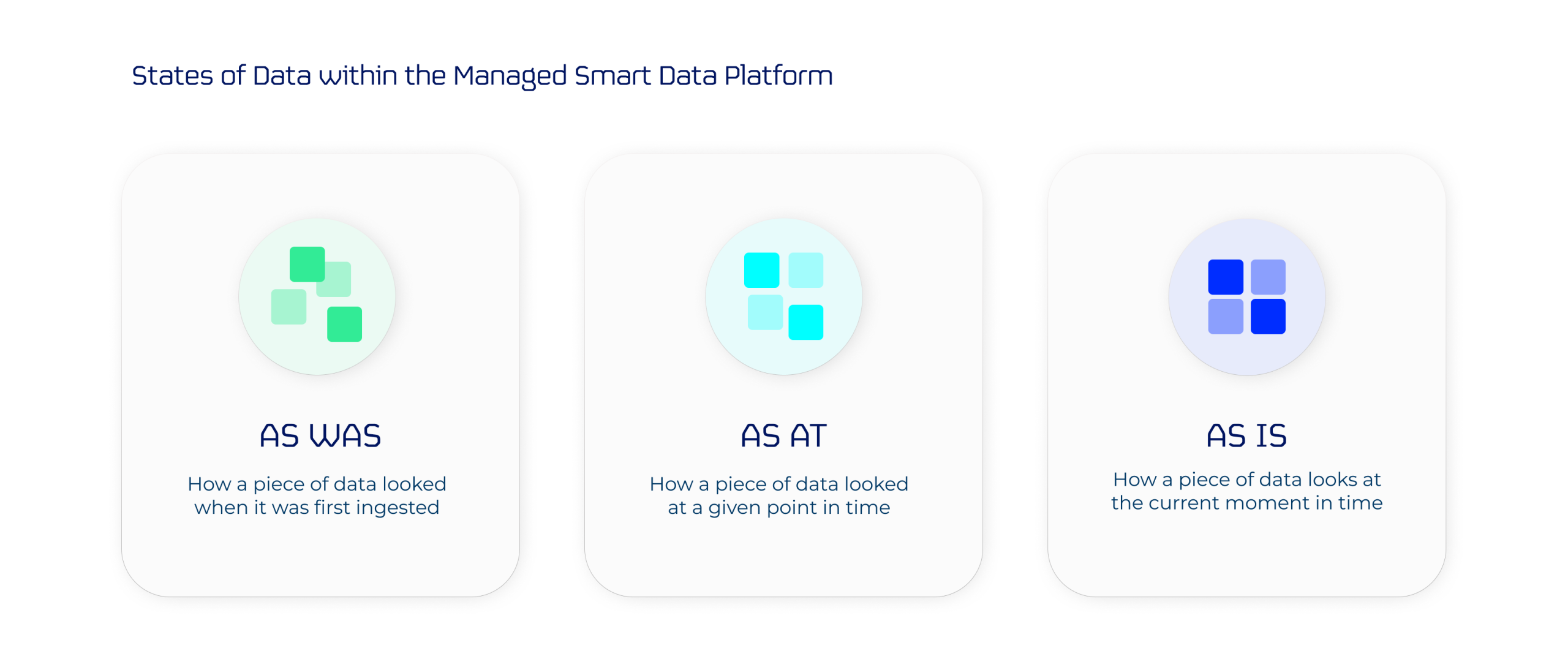
Financial data is complex and dynamic. The ability to access, analyse and compare different versions of your data, at different points in time, can be a powerful tool for businesses. It can enhance data analysis, make regulatory compliance easier, and streamline operational processes.
At Raw Knowledge, we make accessing historical snapshots of your data easier thanks to our Managed Smart Data Platform’s in-built time travel capabilities. This automated and comprehensive functionality allows businesses to quickly analyse and compare how a piece of data looked months ago to how it looked days ago, without impacting its current state.
Learn more about our time travel functionality, how it works and what it can do to help drive your business forward below.
Click to jump to a specific section:
What is time travel in data management?
Time travel is a feature within the Managed Smart Data Platform that allows users to reconstruct a piece of data as it existed at any given point in time, without affecting the current state of that data.
Our platform achieves this by maintaining a historic record of all the changes users have made to a piece of data. Copies of these alterations are automatically made each time a change occurs, and the changes are stored separately from the current version. This prevents prior versions being overwritten and allows users to access different versions simultaneously.
How is it different to data versioning?
Time travel and data versioning are similar concepts within data management. They both involve tracking changes made to individual pieces of data over time; however, they do this in very different ways.
Data versioning often needs more active management from users, usually requiring them to manually decide when copies of their data are made. This means that data management platforms using data versioning don’t necessarily save a full timeline of changes made to a piece of data.
In contrast, time travel maintains an unbroken timeline of all changes made to a piece of data through its entire lifecycle. By doing so, it allows users to reconstruct a view of data as it was at any point in its existence, enabling them to ‘travel through time’. This includes tracking when data has been deleted from source and if it is subsequently reinstated at source.

How does it work in the Managed Smart Data Platform?
Each time a piece of data is changed, no matter how small this change is, the Managed Smart Data platform will assign a unique version number along with audit timestamps. This is done automatically, without requiring manual backups or duplicating data.
This method of handling changing data attributes is commonly referred to as slowly changing dimensions, or SCD. At Raw Knowledge, the SCD approach we take as part of our time travel capabilities is SCD Type Two.

How could my business use the functionality?
Swift data recovery: In the event of data loss or corruption, our time travel functionality allows users to access and revert to previous versions of their data. This provides users with a safety net, should things go awry.
Improved data analysis: By providing a complete record of an organisation’s data, our time travel functionality enables users to analyse how their data has changed over time. This helps unlock deeper data insights through the identification of trends and anomalies.
Enhanced trend prediction: As our time travel functionality supports users in identifying historic trends within their data landscape, it can also support them in making more accurate, data-driven predictions. This aids in strategic planning and can support the pursuit of new revenue targets.
Easier compliance: The Managed Smart Data Platform’s time travel functionality is incredibly useful in supporting business’s compliance efforts. This is because the functionality provides clear visibility across what changes were made to a piece of data, when these changes occurred and who was responsible for the change. This transparency then makes providing a clear audit trail easy.
Reproduce reports: Our time travel functionality makes reproducing reports easy by allowing users to access data from a specific point in time when conducting their analysis. This prevents users from being caught out by upstream changes to datasets.
Can time travel help with tracking data lineage?
Data lineage is the process of tracking data through its lifecycle, from creation to end destination. It provides a record of where data originates, how it moves through your organisation and how it gets transformed along the way.
It plays an important role in compliance and robust data governance, allowing organisations to track whether their data is being used appropriately and in accordance with any external regulation or internal policies.
It also helps ensure data integrity and quality by helping users understand how their data has evolved.
As the Managed Smart Data Platform’s time travel capabilities provide a complete and comprehensive record of all changes made to your data, our platform can help you in your efforts to accurately track lineage over time. Each individual data item is traceable back to source and this information grows over time to provide a rich insight into not only how your data is evolving, but also why it is evolving.



